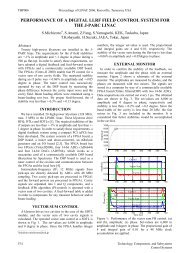Design and Development of a Diagnostics Client for a Beam Loss ...
Design and Development of a Diagnostics Client for a Beam Loss ...
Design and Development of a Diagnostics Client for a Beam Loss ...
You also want an ePaper? Increase the reach of your titles
YUMPU automatically turns print PDFs into web optimized ePapers that Google loves.
<strong>Design</strong> <strong>and</strong> <strong>Development</strong> <strong>of</strong> a <strong>Diagnostics</strong> <strong>Client</strong> <strong>for</strong> a <strong>Beam</strong> <strong>Loss</strong> Measurement System at CERN<br />
Bits Name Description<br />
31 Acquisition/status 0 - acquisition data<br />
1 - status data<br />
30:29 Acquisition Data type 00 - processed data FDFC<br />
01 - processed data DADC<br />
28:26 Acquisition channel channel number 0 to 7<br />
25:20 Debug Counter Increasing counter value 0-63 (<strong>for</strong> debug purposes). When<br />
counter riches max value it will roll back to 0.<br />
19:0 Payload Processed data value (unsigned integer number)<br />
4.3.3.2 BLEDP Status Frame<br />
Table 1: BLEDP Acquisition Frame<br />
The second type <strong>of</strong> data sent by the embedded server is the status data frames. Status<br />
data refer to a number <strong>of</strong> sensors on the card <strong>and</strong> also several other parameters to be<br />
monitored (e.g. Temperature). This status data is interleaving in parallel with the acqui-<br />
sition data frames at 1 Hz frequency. Status data are transmitted exclusively through the<br />
TCP socket regardless <strong>of</strong> the protocol used <strong>for</strong> the transmission <strong>of</strong> acquisition data (TCP<br />
or UDP).<br />
As already discussed, acquisition buffers (bundles) are sent through the network with a<br />
constant rate. The same principle is applied to the status data, so they are collected by<br />
the hardware <strong>and</strong> then packed by the server into fixed-size buffers <strong>and</strong> afterwards sent<br />
through the network. This fixed-size buffer transmission takes place every 1 second <strong>of</strong><br />
acquisition time. The size <strong>of</strong> the buffer may differ throughout the development process. In<br />
Figure 11 an example <strong>of</strong> how a fixed-size status buffer interleaves between the acquisition<br />
bundles is shown. This example is from a single-channel transmission where in 1 second<br />
<strong>of</strong> acquisition, 1428 to 1429 acquisition data bundles are transmitted.<br />
Figure 11: Status buffer interleaving between acquisition bundles.<br />
The status packet has also a size <strong>of</strong> 32 bits <strong>and</strong> can be distinguished from the acquisition<br />
packet from the top bit (see Table 1). Furthermore, the first 16 bits <strong>of</strong> each status packet<br />
are the header <strong>and</strong> have a hexadecimal value <strong>of</strong> “0x8002”. In order to decode the desired<br />
payload values <strong>of</strong> the status packets (bottom 16 bits) the use <strong>of</strong> a complex memory map<br />
Emmanouil I. Angelogiannopoulos 27















